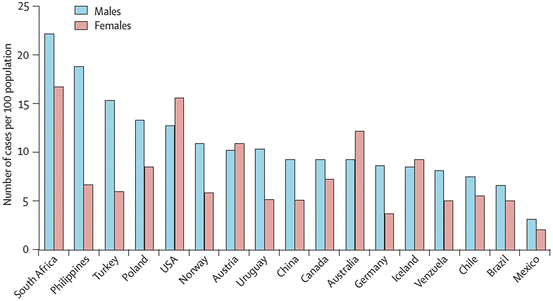Fig. 10.1
Age-adjusted prevalence (%) of self-reported physician-diagnosed COPD among adults ≥25 years, by sex and year—United States, National Health Interview Survey, 1999–2011 [11]
There may be gender differences in the development of early onset COPD. In the COPDGene study, 66 % of subjects with severe early onset COPD were female, whereas only 43 % of older subjects with severe COPD were female [17]. Furthermore, females with COPD were 3.1 times more likely than males with COPD to have a severe early onset diagnosis.
Racial/Ethnic Differences
Data from the US have shown dramatic differences in COPD prevalence in different racial and ethnic groups, ranging from a low of 2.5 % in Asian/Pacific Islanders to 11.0 % in American Indian/Alaskan Natives [11] (Fig. 10.2). This can be contrasted with spirometrically determined COPD from NHANES 2007–2010 data, where 15.3 % of whites, 10.7 % of blacks, 6.3 % of Mexican-Americans, and 9.7 % of people of other races had evidence of COPD [14].
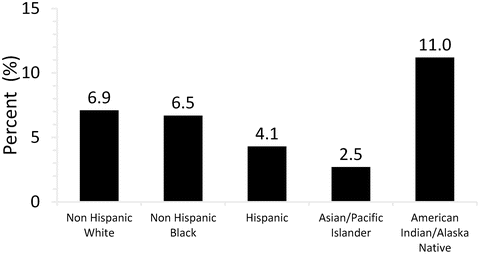

Fig. 10.2
Age-adjusted prevalence of self-reported, physician-diagnosed COPD among adults aged >25, by race/ethnicity: United States (Behavioral Risk Factor Surveillance Survey):2011 [N = 475,616] data from [11]
Recent data suggests that the characteristics of COPD may vary by race. For example, an analysis of the COPDGene computed tomography data suggests that blacks had less emphysema than whites (13.1 % vs. 16.1 %) [18].
As noted above, Hispanic ethnicity is protective against the development of COPD in most US populations. A study of New Mexico Hispanics that used both self-reported and DNA confirmed ethnicity found a lower risk of COPD (vs. whites: OR 0.5) and a lower risk of lung function decline (OR 0.5).
Internationally, it was demonstrated by combining both the BOLD [13] and PLATINO [19] data that countries with the lowest prevalence of COPD were predominantly Hispanic (Fig. 10.3) [20]. The large differences noted here probably reflect a combination of racial, ethnic, geographic, genetic, and exposure factors.
Socioeconomic Differences
One of the most consistent disparities in estimates of COPD prevalence is that related to socioeconomic status (SES ) . In a number of different studies based in different countries and using different measures of SES, a higher prevalence of COPD is observed in lower SES populations (Table 10.1). Although a lower SES is typically related to COPD risk factors such as smoking, multivariate regression models continue to show an SES gradient. For example, in the Yin study of a Chinese population, the low-income group had a significantly higher risk of COPD (OR 2.1) relative to the high-income group.
Table 10.1
Socioeconomic status and COPD prevalence from selected studies
Author/year | Country | SES indicator | Level | COPD prevalence men or overall (%) | COPD prevalence women (%) |
|---|---|---|---|---|---|
Chen/2000 [40] | Canada | Income adequacy | High | 1.6 | 2.6 |
Middle | 2.4 | 4.6 | |||
Low | 6.6 | 6.6 | |||
Ferre/2012 [41]a | France | Annual income | High | 1.9 | |
Middle | 3.6 | ||||
Low | 3.4 | ||||
Very Low | 5.3 | ||||
Kanervisto/2011 [42] | Finland | Household income | High | 3.1 | |
Middle | 3.4 | ||||
Low | 9.2 | ||||
Yin/2011 [43] | China | Income | High | 2.0 | |
Middle | 2.4 | ||||
Low | 4.2 | ||||
Ford/2013 [14] | United States | Education (years) | >12 | 12.4 | |
12 | 15.7 | ||||
<12 | 14.3 | ||||
Danielsson/2012 [44] | Sweden | Education (years) | >12 | 11.4 | |
12 | 12.6 | ||||
<12 | 28.0 |
Geographic Differences
As noted above, the BOLD and PLATINO studies demonstrated a great deal of variability in the prevalence of COPD between different populations in different countries (Fig. 10.3) [13]. In the BOLD study, COPD among women ranged from 5·1 % in Guangzhou, China, to 16·7 % in Cape Town, South Africa, and in men it ranged from 8·5 % in Reykjavik, Iceland, to 22·2 % in Cape Town, South Africa.
In the United States, the rate of COPD varies from state to state, from a low of 4.3 % in Utah to a high of 10.6 % in Kentucky [11]. Smaller area data are not yet available for COPD prevalence, although it is highly likely that prevalence rates in counties or health districts also show considerable variation. This variation is related to a number of factors including the key COPD risk factors like smoking and occupational exposures, in addition to poverty, early life respiratory infections, diet, physician diagnostic differences, and other factors [20].
Disparities in Treatment
Access to care and use of efficacious medications can help avoid harm in patients with COPD. Few studies have specifically examined differences in access to care or use of COPD treatments across patient populations, but the available evidence suggests that disparities in treatment exist across different patient groups. Tiotropium, introduced in the U.S. in 2004, is a long-acting analog of the inhaled anticholinergic medication ipratropium bromide. In placebo-controlled randomized clinical trials, tiotropium has been shown to significantly improve health-related quality of life (St. George’s Respiratory Questionnaire) and dyspnea (Transitional Dyspnoea Index); lung function; and lower the risk of exacerbations, hospitalizations, and mortality [21–23]. In a study conducted 2 years after the introduction of tiotropium in the U.S., investigators observed that a lower SES was strongly associated with decreased odds of using tiotropium, even after taking into account measures of disease severity [24]. Patients with lower levels of education (less than or equal to high school) or income (<$20,000) had one-third the odds of using tiotropium compared to their more advantaged counterparts. Results of a more recent study among patients enrolled in COPDGene (published as an abstract in 2010) also suggest that black race is associated with significantly lower use of tiotropium [25]. Differences in access to therapy probably exist for other types of COPD interventions, including medications, noninvasive ventilation, and lung transplantation [26, 27]. Thus, these findings raise concerns about the potential for differences in the quality of care contributing to COPD disparities in outcomes.
Disparities in Outcomes
This section will examine differences and disparities in morbidity and mortality among patients with COPD.
Morbidity
Key measures of COPD-related morbidity include exacerbation events and health-related quality of life (HRQOL). Exacerbations of COPD are related to a number of factors [28] and commonly result in emergency room visits and hospitalizations. In 2010 the United States had an estimated 699,000 hospitalizations, or an age-adjusted rate of 32.2 per 10,000 U.S. civilians, for patients at least 25 years of age with a first-listed diagnosis of COPD [11]. Hospitalization rates were similar between men (31.6 per 10,000) and women (33.4 per 10,000) but were higher in blacks (39.5 per 10,000) compared with whites (29.5 per 10,000). This is in spite of a national trend observed with hospitalization rates decreasing for all adults between 1999 and 2010 [11].
When observing only Medicare enrollees of at least 65 years of age, there were 312,654 hospital discharge claims, or an age-adjusted rate of 11.18 per 1000 enrollees, with a first-listed diagnosis of COPD in 2010. Hospitalization rates for Medicare enrollees were similar for men (11.6 per 1000) and women (10.0 per 1000). With respect to race and ethnicity, the hospitalization rates were the highest for Native American enrollees (13.2 per 1000), followed by black enrollees (12.4 per 1000), white enrollees (11.3 per 1000), Hispanic enrollees (9.7 per 1000), and Asian enrollees (4.8 per 1000). From 1999 to 2010, Medicare hospitalizations decreased for enrollees overall and for men, but not significantly for women or any specific race/ethnicity group (Fig. 10.4) [11].
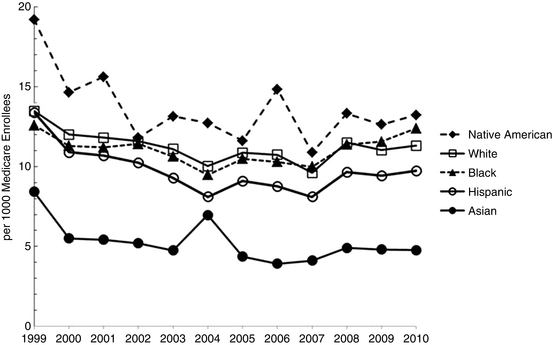

Fig. 10.4
Race-specific age-adjusted rates (per 1000 Medicare enrollees) of Medicare hospitalizations for COPD as the first-listed discharge diagnosis among Medicare enrollees aged >65 years, by year—United States, Medicare Part A hospital claims, 1999–2010 [11]
A COPD-related hospitalization increases the risk of subsequent mortality independent of the baseline level of lung function [29]. African Americans hospitalized with COPD exacerbations have a higher 30-day readmission rate compared with white patients (23.1 % vs. 20.5 %) [30]. Income is also associated with 30-day readmission rates after COPD exacerbations; patients living in areas with a median household income in the lowest quartile have a higher readmission rate compared with patients living in areas with the highest quartile of income (21.5 % vs. 20.2 %).
Many factors can affect HRQOL in COPD patients, including age and sex. Other factors that affect HRQOL, such as lung function, smoking history, current smoking status, and education, tend to vary by race. However, even after adjusting for these and additional confounders, disparities in HRQOL can still be found between African Americans and Caucasians. Data from the COPDGene study was used to examine differences in HRQOL according to the St. George Respiratory Questionnaire (SGRQ) [31]. For COPD patients with no exacerbations reported in the prior year, SGRQ scores were similar for African Americans and Caucasian patients. However, African American patients that reported exacerbations in the previous year averaged 1.89 points higher (i.e., worse HRQOL) on the SGRQ per exacerbation than Caucasians. Additionally, more African Americans had at least one exacerbation requiring hospitalization (32 %) than Caucasians (16 %). Of those patients reporting exacerbations requiring hospitalization, African Americans tended to score 4.19 points higher on the SGRQ measure per exacerbation than Caucasians.
Similarly, outcomes of COPD severity, pulmonary function, physical function limitations, and risk of exacerbation have been shown to vary by certain demographic factors. A cohort of COPD patients from the Function, Living, Outcomes, and Work study were analyzed for associations between outcomes and demographic factors of race, education, and income after controlling for a multitude of covariates [32]. Both lower education and lower household income were associated with higher COPD severity and poorer lung function (FEV1%) when compared to their high education and income counterparts. Lower income groups also performed poorer in physical function than did the high-income group. The lowest education and income groups were found to have more severe airflow obstruction (FEV1/FVC) and a higher risk of exacerbation requiring hospitalization when compared to the highest education and income groups. The lowest education group also showed poorer physical function relative to the highest education group. With respect to race, black subjects had better lung function (FEV1%) but poorer physical function when compared to white subjects.
Mortality
There were 133,575 deaths in the U.S. in 2010 that were attributed to COPD, corresponding to an age-adjusted rate of 63.1 per 100,000 people. This death rate decreased from 1999 to 2010 for men, but did not change in women or overall. Death rates were highest in 2010 among whites (70.2 per 100,000), followed by American Indian/Alaska Natives (62.9 per 100,000), blacks (41.8 per 100,000), Hispanics (28.5 per 100,000), and Asian/Pacific Islanders (19.0 per 100,000) [11] (Fig. 10.5). Of note, between 1980 and 2002, death rates for African American COPD patients increased at a higher rate than for Caucasian COPD patients [33].
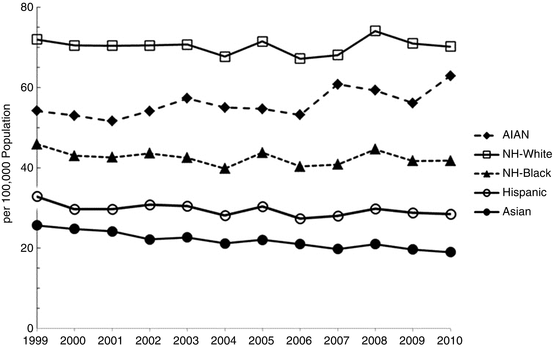

Fig. 10.5
Race-specific age-adjusted death rates (per 100,000) for COPD as the underlying cause of death among adults aged >25 years, by year—United States, Mortality Component of the National Vital Statistics System, 1999–2010 [11]
Disparities in Research Funding
Another key disparity in COPD relates to the research funding this disease receives relative to the impact of the disease on the US population. When Gillum et al. evaluated this looking at 2006 data, they found that COPD was one of the most underfund diseases by the National Institutes of Health relative to the number of disability adjusted life years for COPD [34] (Fig. 10.6). Since 2006, COPD federal funding has increased dramatically with projects such as COPDGene [35] and the Long-Term Oxygen Treatment Trial (LOTT).
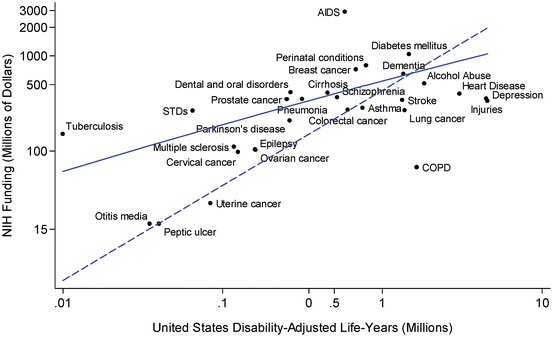 < div class='tao-gold-member'>
< div class='tao-gold-member'>





Only gold members can continue reading. Log In or Register to continue
Stay updated, free articles. Join our Telegram channel

Full access? Get Clinical Tree


